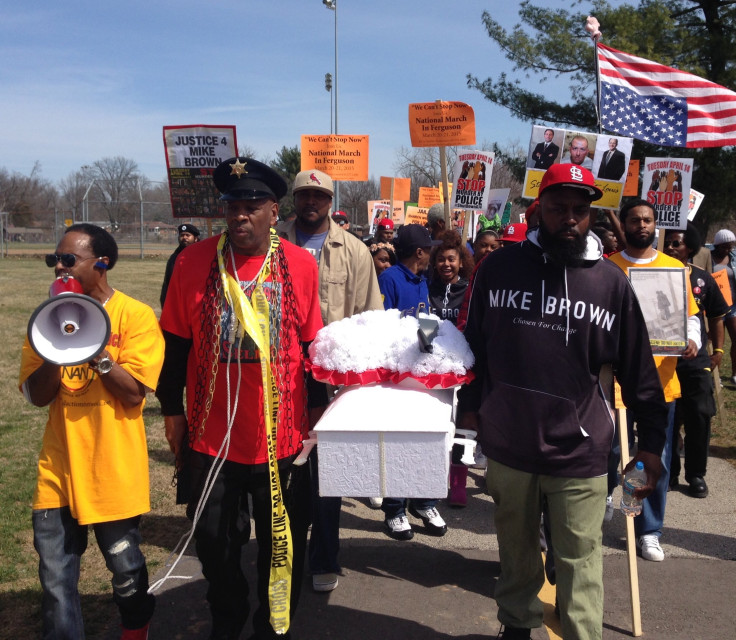Will Ferguson's Next Police Chief Be Black? Demonstrators Direct Anger At Law Enforcement In Weekend Of Protests

FERGUSON, Missouri -- Damien White moved to Ferguson from nearby St. Louis just a few weeks before Michael Brown, a black and unarmed 18-year-old, was fatally shot by a white cop, triggering a series of events that resulted in a federal probe into the Ferguson Police Department and the resignation of its chief. White, who has a 1-year-old son, said he didn’t care if the next city police chief is white or black -- whoever it is needs to “just be real.”
“We just need the right chief, so that 17 years from now, when my son is 18, I won’t have to worry that he’ll get killed,” White said.
More than seven months after Brown’s death sparked civil unrest in Ferguson and other communities across the nation, residents from towns throughout northern St. Louis County are still angry over how law enforcement handled the shooting. Former Ferguson police Officer Darren Wilson will not face charges in connection with Brown's Aug. 9 death. The U.S. Department of Justice, however, recently criticized Ferguson’s police department in a scathing report revealing what many local residents said they knew too well -- that for years, African-American residents were targeted with tickets, arrests and jail time for the city’s financial gain.
The Justice Department report prompted the resignations of the city’s manager, municipal court judge and, as of Thursday, police Chief Tom Jackson. As Ferguson begins to revamp its largely white police department and mull how to best move forward, increased racial diversity within the department was one of several demands made by more than 70 protesters, among them the slain man’s father, Michael Brown Sr., who marched outside police headquarters Saturday. If the city’s population is two-thirds African-American, the makeup of the city’s police force should be, too, the group of mostly Ferguson-area residents said. The Leadership Coalition for Justice, a community group that organized Saturday’s march, cited the officials’ departure as evidence that their anger and protests were being heard in Ferguson and around the country.
'Community Control'
“We cannot let this go,” said Anthony Shahid, one of several speakers at a rally before the milelong march from Forestwood Park to the police station on South Florissant Road. “We have to have community control of the police department.”
Gwen Stewart, a 69-year-old resident of an unincorporated part St. Louis County, said she marched for her two grown daughters and teenage grandsons. “We need to dismantle the police department -- they need to start from scratch,” Stewart said. “If [officers] were there when they were doing the ticket scheme, if they knew about it and didn’t say anything, then they’ve got to go.”
In the Justice Department report released March 4, federal officials said African-Americans in Ferguson accounted for 85 percent of drivers in police traffic stops, 90 percent of traffic-ticket recipients, and 93 percent of those arrested. Most offenses carried fines and required court appearances. Citizens who couldn’t afford to pay or missed multiple court dates were subject to arrests and jail time, according to the DOJ report. Email communications sent between city officials included depictions of President Barack Obama as a chimpanzee and jokes about African-American families.
On Saturday, protesters’ remarks about the majority-white police force and elected officials were equally offensive. Some dismissed all cops as part of a “racist, criminal enterprise” that had committed a “hate crime” against blacks, one rally speaker said. Marchers chanted along the route, as a few spectators looked on from their homes, or from restaurants or bars. “No justice, no peace! No racist police,” marchers shouted.
'It's A Lie'
They also chanted “Hands up, don’t shoot,” which has become a national rallying cry for justice for Brown. The chant drew an angry response from a white couple leaving the Ferguson Brewing Company restaurant on South Florissant. The Justice Department investigation of Brown’s death found no evidence that the young man had his hands up in surrender before Wilson fatally shot him. “It’s a lie,” a white woman shouted at the mostly African-American protesters as she directed a thumbs-down gesture toward them.
When the marchers arrived at the police station, those carrying a small white casket representing the slain man placed the box at the building's entrance. More than two-dozen police officers and troopers in riot gear had formed a line across the station parking lot and moved protesters back to an area of South Florissant that was approved for protests.
"Chief!" the protesters shouted repeatedly.
Louis Wilson, a black man in his 60s who has lived in Ferguson since 1998, said he would like to see an African-American police chief in the city. “We need someone who is actually transparent, not someone who just says they are,” he said.
© Copyright IBTimes 2024. All rights reserved.






















